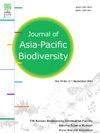中国中部七星瓢虫(鞘翅目:瓢虫科)遗传多样性及DNA条形码分析
IF 0.7
Q4 BIODIVERSITY CONSERVATION
引用次数: 0
摘要
七星瓢虫(Coccinella七星瓢虫,1758)是一种重要的生物防治剂。了解其遗传多样性对生物多样性保护和有效的病虫害管理至关重要。我们分析了2020年至2023年间收集的中国中部5个省份71个个体的DNA条形码(线粒体cox1基因)序列,并鉴定出19种不同的单倍型,突出了显著的遗传多样性。多样性最高的是甘肃省,最低的是四川省的一系列标本。系统发育分析和单倍型网络没有显示出强烈的地理聚类,这表明基因在种群之间频繁流动。跨区域共享的单倍型进一步支持了这一结论。这些结果为七星瓢虫的分子鉴定提供了新的DNA条形码资源,并强调了保护七星瓢虫遗传多样性以维持生物多样性的必要性。本文章由计算机程序翻译,如有差异,请以英文原文为准。
Genetic diversity and DNA barcoding of Coccinella septempunctata (Coleoptera: Coccinellidae) from central China
The seven-spot ladybird Coccinella septempunctata Linnaeus, 1758 is an important biological control agent. Understanding its genetic diversity is vital for biodiversity conservation and effective pest management. We analyzed the DNA barcoding (mitochondrial cox1 gene) sequences from 71 individuals across five provinces in central China, collected between 2020 and 2023, and identified 19 distinct haplotypes, highlighting significant genetic diversity. The highest diversity was observed in Gansu province, while a series of specimens from Sichuan province displayed the lowest diversity. Phylogenetic analysis and haplotype networks did not reveal strong geographic clustering, suggesting frequent gene flow among populations. Shared haplotypes across regions further support this conclusion. These results provide new DNA barcoding resources for the molecular identification of C. septempunctata and highlight the necessity of preserving genetically diverse populations to maintain biodiversity.
求助全文
通过发布文献求助,成功后即可免费获取论文全文。
去求助
来源期刊

Journal of Asia-Pacific Biodiversity
Agricultural and Biological Sciences-Insect Science
CiteScore
1.70
自引率
12.50%
发文量
94
审稿时长
27 days
期刊介绍:
The Journal of Asia-Pacific Biodiversity (previous title was Journal of Korean Nature) is an official journal of National Science Museum of Korea (NSMK) and Korea National Arboretum (KNA). The scope of journal is wide and multidisciplinary that publishes original research papers, review articles, as well as conceptual, technical and methodological papers on all aspects of biological diversity-its description, analysis and conservation, and its application by humankind. This wide and multidisciplinary journal aims to provide both scientists and practitioners in conservation theory, policy and management with comprehensive and applicable information. However, papers should not be submitted that deal with microorganisms, except in invited paper. Articles that are focused on the social and economical aspects of biodiversity will be normally not accepted.
 求助内容:
求助内容: 应助结果提醒方式:
应助结果提醒方式:


